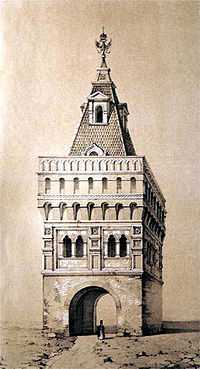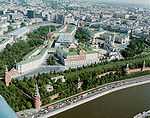Armorial Gate

The Armorial Gate (Russian: Гербовые ворота, Gerbovye vorota) was a unique monumental erection of traditional Russian architecture. Situated in the Moscow Kremlin, the structure was symbolic of the centralized Russian state. Its name references polychrome tiles of the second floor, which displayed heraldic emblems of formerly independent Russian principalities.
When constructing a palace for Ivan III in the late 15th century, the Italian architect Aloisio built an interior brick wall inside the Kremlin to defend the royal palace from south and west. The western wall was pierced by two arches, the smaller for pedestrians and the larger for vehicles. The larger gate was called Kolymazhnye, either from the old Russian word for vehicles or from the Kolymazhny Chamber situated nearby.
After the Romanov family ascended the throne in 1613, they rebuilt Ivan's residence into the Terem Palace. At about the same time, in the 1630s, they commissioned a tower to crown the Kolymazhnye Gate leading to the royal court.
The tower was square in plan, with the first floor pierced by a wide arch for vehicles. The second floor had twin double-arched windows with decorative elaborations of white stone. The third floor was pierced by a row of machicolations and a row of murder-holes. Above that was a gallery ringed by a perforated parapet. The structure was crowned by a tiled tent, decorated with two levels of dormers and surmounted by a heraldic double-headed eagle.
By the 19th century, the wall had lost its defensive purpose and was dismantled. After that, the detached tower appeared redundant and was pulled down at the urging of the Kremlin's castellan in 1807.
Sources
- (Russian) Official website of the Kremlin museums
